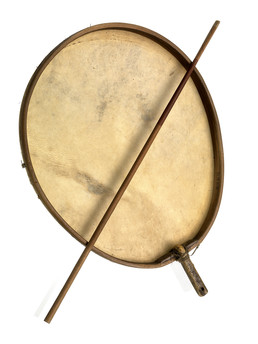e. Qilaun (Hand Drums)
–Sarah Diver
The Inupiaq Hand Drum
Used throughout the circumpolar region by many indigenous groups, this tambourine-style hand drum, called the qilaun, almost always accompanies ceremonial singing, dancing, or chanting, and it is synonymous with the celebration of special events in Inupiaq life.[1] The frame of the drum was made by soaking and steaming a long, smoothed piece of wood until it was pliable enough to bend into its distinctive round shape.[2] The handle, which aided the beveled seam of the drum to remain in place, could be made of bone, antler, or ivory and was often carved.[3] The drumhead could be the membrane of a bowhead whale liver or sometimes the lining of seal or caribou intestine as in the drums shown above (Figure 5).[4] Used in tandem often with the large box drum (kalukaq), the qilaun was played by hitting the back of the frame with a thin stick rather than hitting the stretched membrane drum face.[5]
In the Messenger Feast, the qilaun and the kalukaq were used to simulate the beating heart of the Eagle Mother, who teaches the Inupiaq hunter how to sing, dance, and feast so that the animals he hunts may have their souls returned.[6]
The Inupiaq Hand Drum in the Avery Properties Drawings
Depictions of the qilaun can be found in Drawings C and K. Set to the side or bottom edge of the composition, the qilaun players frame the dancers in the center of the drawings. In Drawing K, the careful representation of the players and their drums emphasizes the number of people participating and their importance to the dancers’ performance. Because the qilaun was a solely ceremonial object, its presence in these drawings designates the images as depictions of a special or sacred event.
[1] Burch, Ernest S. “The Economic Process.” Chap. 4 In Social Life in Northwest Alaska : The Structure of iñUpiaq Eskimo Nations, 258. Fairbanks: University of Alaska Press, 2006.
[2] Ibid.
[3] Ibid.
[4] Ibid.
[5] Ikuta, Hiroko. “Inupiaq Pride: Kivgiq (Messenger Feast) on the Alaskan North Slope.” érudit 31, no. 1-2 (2007): 345-346.
[6] Ibid.

Leave a Reply
You must be logged in to post a comment.